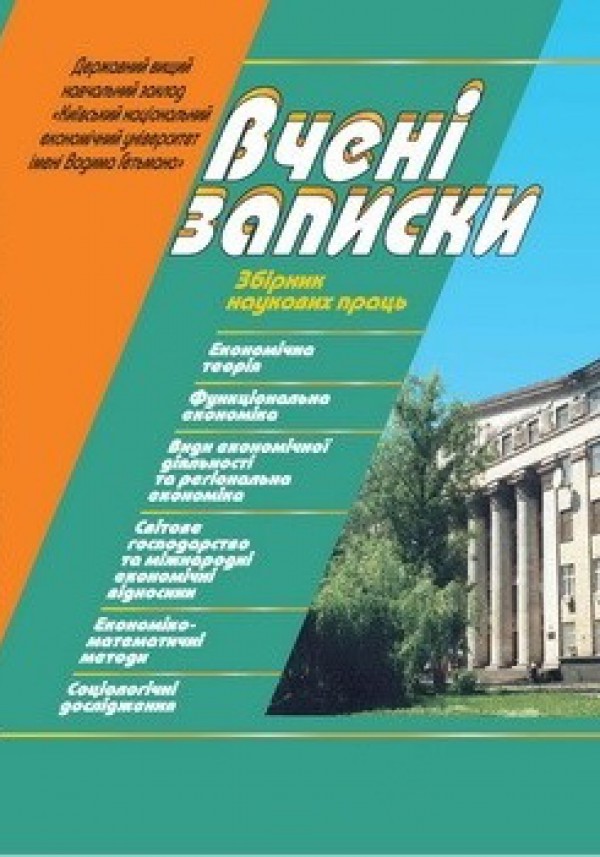
Collection of Scientific Papers "Scientific Notes"
ISSN 2415-8518
Постіндустріальна трансформація механізмів економічної циклічності
Post-industrial transformation of economic cyclicality mechanisms
DOI:
10.33111/vz_kneu.26.22.01.05.033.039
Анотація: У статті уточнено теоретичне бачення механізмів економічної циклічності в умовах постіндустріальної трансформації економічної системи, зокрема, вплив постіндустріальних трансформацій виробництва на характеристики економічних систем, що перебувають у фокусі інституціональних теорій. Обґрунтовано, що зниження сили впливу відтворення фізичного капіталу на формування імпульсів циклічності, вимагає не абсолютного зниження капіталомісткості національного продукту, а відносного. Це означає, що навіть за зростання капіталомісткості випуску, вагомість фізичного капіталу може скорочуватись унаслідок того, що інформаційна, чи наукова місткість продукції зростає швидше, отже питома вага належної капіталу складової нової вартості скорочується. Визначено, що оскільки нематеріальні активи не підлягають фізичному зношенню, а заміщуються лише в міру морального старіння, то інтенсивність використання таких активів не впливає на швидкість їх зношення. Така властивість нематеріальних активів сприяє обмеженню амплітуди циклічних коливань, тобто виступає «вбудованим стабілізатором», на відміну від механізмів відтворення фізичного капіталу, що сприяли її зростанню.
Abstract: That article is devoted to clarifying the theoretical vision of the economic cyclicality under the conditions of economic systems post-industrial transformation. In particular, taking into account the impact of post-industrial transformations (The increasing in the share of intangible production in gross value added and an increasing of the weight of intangible assets in gross capital formation were used as the indicators of such transformations) on the characteristics of economic systems, which are in focus of institutional theories (in particular the size of transactional costs, the costs and duration, inherent to processes of «imitation of leaders», the strength of motives and incentives for entrepreneurs’ innovation activities). It is substantiated that the reduction of the impact force, which the reproduction of physical capital has on the formation of cyclical impulses does not require an absolute reduction in the capital intensity of the national product (which is not observed in developed countries), but relative. This means that even with increasing capital intensity of output, the weight of physical capital may decrease due to the fact that information or scientific capacity of products grows faster, so the share of physical capital in the new value structure is reduced. It is also determined that since intangible assets are not subject to physical wear and tear, and are replaced only as they age, the intensity of its using does not affect the rate of capital depreciation. This property of intangible assets helps to limit the amplitude of cyclical fluctuations, i.e. acts as a «built-in stabilizer», in contrast to the mechanisms of reproduction of physical capital, which contributed to the increase in the amplitude of cyclical fluctuations.
Ключові слова: теорії економічного циклу, нематеріальне виробництво, нематеріальні активи, інноваційна активність, біфуркація економічної динаміки
Key words: economic cycle theories, intangible production, intangible assets, innovation activity, bifurcation of economic dynamics
УДК: 330.33.01;338.1
UDC: 330.33.01;338.1
JEL: E32 O33 O43
To cite paper
In APA style
Drobyazko, M. (2022). Post-industrial transformation of economic cyclicality mechanisms. Collection of Scientific Papers "Scientific Notes", 26 (1), 54-65. http://doi.org/10.33111/vz_kneu.26.22.01.05.033.039
In MON style
Дроб’язко М.М. Постіндустріальна трансформація механізмів економічної циклічності. Вчені записки. 2022. № 26(1). С. 54-65. http://doi.org/10.33111/vz_kneu.26.22.01.05.033.039 (дата звернення: 27.04.2025).
With transliteration
Drobyazko, M. (2022) Postindustrialna transformatsiia mekhanizmiv ekonomichnoi tsyklichnosti [Post-industrial transformation of economic cyclicality mechanisms]. Collection of Scientific Papers "Scientific Notes", no. 26(1). pp. 54-65. http://doi.org/10.33111/vz_kneu.26.22.01.05.033.039 [in Ukrainian] (accessed 27 Apr 2025).
.jpg ) # 26(1) / 2022
# 26(1) / 2022
Download Paper
1
Views
0
Downloads
0
Cited by
- North, D. C., Wallis, J. J., & Weingast, B. R. (2012). Violence and Social Orders: A Conceptual Framework for Interpreting Recorded Human History (Reprint ed.). Cambridge University Press.
- Meier, G. M., & Rauch, J. E. (2005). Leading Issues in Economic Development (8th ed.). Oxford University Press.
- Lukyanenko, D. G., & Poruchnyk, A. M. (Eds.). (2010). Countercyclical regulation of a market economy: a globalization perspective. KNEU.
- Lucas, Robert E., 1977. «Understanding business cycles,» Carnegie-Rochester Conference Series on Public Policy, Elsevier, vol. 5(1), pages 7-29, January.
- Kuznets, S. Economic Growth and Income Inequality // American Economic Review. 1955. Vol. 45. № 1. — P. 3-8, 18-26.
- Nelson, R. R., & Winter, S. G. (1985). An Evolutionary Theory of Economic Change (Belknap Press). Belknap Press: An Imprint of Harvard University Press.
- Schumpeter, J. A. (2021). The Theory of Economic Development (Routledge Classics) (1st ed.). Routledge.
- Harrod, R. (2016). Towards a Dynamic Economics. Palgrave Macmillan.
- Solow R.M.A Contribution to the Theory of Economic Growth.- Quarterly Journal of Economics 70 (February 1956), p. 65 — 94;
- Lucas, R. E., Jr, (1980). Methods and Problems in Business Cycle Theory. Journal of Money, Credit and Banking, Blackwell Publishing, 12(4), 696-715.
- Hayek F.A. Monetary theory and The trade cycle. Translated from the Germen by N. Caldor and H.M. Groom. N.Y. 1934.
- Fetisov, G. G., & Khudokormov, A. G. (Eds.). (2004b). World economic thought. Through the prism of centuries. Mysl’.
- Inozemtsev, V. L. (Ed.). (1999). New post-industrial wave in the West. Anthology. Academia.
- Lukyanenko, D. G., A. Poruchnik, A. M., & Kolesov, V. L. (Eds.). (2013). Global economic development: trends, asymmetries, regulation. KNEU.
- Quantitative Aspects of the economic growth of Nations: X. Level and structure of foreign trade: Long-Term trends. Econ. Develop. Cult. Change, Jan. 1967, 15 (2 part II), p. 1 — 140.
- Inozemtsev, V. L. (1999a). A Divided Civilization: Prerequisites and Possible Consequences of the Post-Economic Revolution. Academia.

